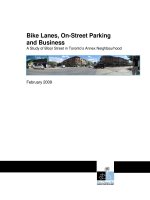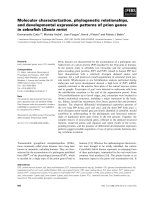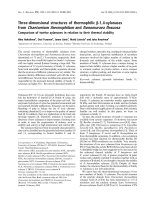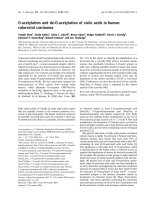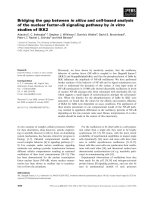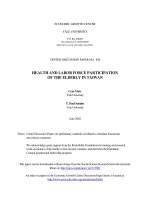Combined power ratio calculation, hadamard transform and lms based calibration of channel mismatches in time interleaved ADCs
Bạn đang xem bản rút gọn của tài liệu. Xem và tải ngay bản đầy đủ của tài liệu tại đây (1.04 MB, 11 trang )
VNU Journal of Science: Comp. Science & Com. Eng, Vol. 36, No. 2 (2020) 1-11
Original Article
Combined Power Ratio Calculation, Hadamard Transform
and LMS-Based Calibration of Channel Mismatches
in Time-Interleaved ADCs
Van-Thanh Ta, Van-Phuc Hoang*
Le Quy Don Technical University, 236 Hoang Quoc Viet Str., Hanoi, Vietnam
Received 05 December 2019
Revised 14 March 2020; Accepted 07 May 2020
Abstract: This paper presents a method for all-digital background calibration of multiple channel
mismatches including offset, gain and timing mismatches in time-interleaved analog-to-digital
converters (TIADCs). The average technique is used to remove offset mismatch at each channel.
The gain mismatch is calibrated by calculating the power ratio of the sub-ADC over the reference
ADC. The timing skew mismatch is calibrated by using Hadamard transform for error correction
and LMS for timing mismatch estimation. The performance improvement of TIADCs employing
these techniques is demonstrated through numerical simulations. Besides, achievement results on
the field-programmable gate array (FPGA) hardware have demonstrated the effectiveness of the
proposed techniques.
Keywords: Time-interleaved analog-to-digital converter (TIADC), channel mismatches, all-digital
background calibration.
1. Introduction *
speed of TIADC increases M times compared to
sub-ADC, where M is the number of sub-ADCs
used for time-interleaving [2-4]. However, the
performance of TIADCs is severely degraded
by mismatches between sub-ADCs, including
offset, gain, timing, and bandwidth mismatches
[4, 5]. Therefore, correcting these mismatches
is a very essential requirement.
There have been several works on
compensating mismatches in TIADCs [6-17].
Among these works, some researchers calibrate
in either all-analog domain [6] or mixed-signal
domain [7]. All-analog calibration techniques
can be performed with any input signal, but
Recently, time-interleaved analog-to-digital
converters (TIADCs) are known and widely
used in high-speed wireless applications [1]. It
uses M sub-ADCs that have a low sampling
frequency to sample the analog input signal in a
time-interleaving manner. The digital output of
sub-ADCs is then multiplexed together to form
the digital output of TIADC. Therefore, the
_______
*
Corresponding author.
E-mail address:
/>
1
2
V-T. Ta, V-P. Hoang / VNU Journal of Science: Comp. Science & Com. Eng., Vol. 36, No. 2 (2020) 1-11
analog estimation is difficult to implement and
is not suitable for CMOS technology. Mixedsignal calibration techniques require low power
consumption and small chip area. However, its
correction is inaccurate and requires an
additional analog circuit. Therefore, it reduces
the resolution of TIADC and increases the
calibration time. Moreover, they are not
portable between CMOS technology nodes.
Thanks to the sinking of CMOS technology, the
all-digital calibration techniques are currently
preferred. These techniques usually only focus
on correcting one or two types of deviations
(usually gain and/or timing mismatch) but do
not include offset one [8-10, 12-17]. The
authors in [8] are only calibrated timing
mismatch by using the polyphase structure for
good results. However, this technique cannot
solve the offset and gain mismatches. The gain
and timing mismatches have been calibrated in
[12]. Nevertheless, convergence time is long
and unverified on hardware. The authors in [11]
corrected all three errors including offset, gain
and timing mismatches. However, the main
limitation of this technique is that there is an
overlap between the desired signal and spurious
signals when the input signal is a single tone
spaced at k M . In our recent work [18], a
calibration technique was proposed for all
offset, gain, and timing mismatches with
preliminary results without hardware validation.
To overcome the limitations of current
techniques, this paper proposes a fully digital
blind calibration technique for offset, gain and
timing mismatches in TIADC. The proposed
technique first calibrates the offset error by
taking the average of sub-ADC output samples,
and then calibrate gain by calculating the power
ratio of the sub-ADC with the reference ADC.
Finally, timing skew is calibrated by using
Hadamard transform for correction and LMS
algorithm for estimation. The effectiveness of
the proposed technique is demonstrated by
simulation and verification results on
FPGA hardware.
The proposed technique achieves higher
performance and a faster convergence speed
compared with the previous techniques. This
technique significantly reduces the required
hardware resources, specifically for the
derivative and fractional delay filters for which
no look-up table is required. In addition, the
proposed technique requires only one FIR
filters with fixed coefficients, thus reducing
complexity and hardware resources, as
compared to the bank adaptive filter techniques.
The rest of this paper is organized as
follows. Section 2 introduces the TIADC model
with offset, gain, and timing mismatches.
Section 3 presents the proposed technique of
fully digital background calibration for channel
mismatches. Simulation and experimental
results on FPGA hardware are analyzed and
discussed in Section 4. Finally, conclusion is
carried out in Section 5.
2. System Model
Consider the M-channel TIADC model
consisting of offset, gain, and timing
mismatches in Fig. 1. The channel mismatch of
the ith sub-ADC is characterized by the offset
errors oi , the gain errors g i , and the relative
timing deviations ti for i 0,1,..., M 1.
Without considering the quantization effects,
the ith channel’s digital output can be
expressed as:
yi [k ] gi x (kM i)T ti oi
(1)
Figure 1. Model of a M-channel TIADC with off set,
gain and timing mismatches.
By assuming a bandlimited input signal
X ( j) 0 , with B and B
Ts
, the
V-T. Ta, V-P. Hoang / VNU Journal of Science: Comp. Science & Com. Eng., Vol. 36, No. 2 (2020) 1-11
output of M-channel TIADC including the
errors: offset, gain, and timing mismatches
errors is expressed as [5]:
Y e j
1 1
T k M
M 1
ge
i 0
j k s
M
i
ti
.e
2
jki
M
1
1
T k M
M 1
oi e
i 0
offset values are expressed as follows:
(2)
2
jki
M
k
s
.
M
This expression shows that, in the presence
of all the errors, the input signal is modulated
by the expression between brackets which
combines gain and timing mismatch errors.
These errors appear at each
in k
s
M
frequency, where in is the input frequency.
Additionally, the offset mismatch tones
intervene as signal independent spurious tones
at each k
s
M
mismatch value of the ith channel ADC. Assume
that the input signal is Wide-Sense-Stationary
(WSS), expected value of the input is
approximately
zero,
i.e.
1 N 1
gi x((kM i)Ts ti ) 0 . Thus, estimated
N k 0
j k s
M
3
.
3. Proposed Method
The proposed technique performs offset
mismatch correction before gain and timing
mismatches correction.
Figure 2. Offset mismatch calibration for each sub-ADC.
3.1. Offset Calibration
The offset calibration scheme is illustrated
in Fig. 2. Assume that oˆi is the estimated offset
1
N
1
N
1
N
oˆi
N 1
y [k ]
k 0
i
N 1
(g x((kM i)T
i
k 0
s
N 1
g x((kM i)T
k 0
i
s
ti ) oi )
(3)
ti ) oi oi .
0
The offset error can be calibrated by firstly
averaging the output of each sub-ADC over N
samples as in (3) and then subtracting the
average value from the ADC output as follow:
yˆ offset [k ] gi x((kM i )T ti ) oi oˆi
gi x((kM i)T ti ).
(4)
3.2. Gain Calibration
The signal after calibration of offset
mismatch is expressed in (4). The goal of gain
mismatch estimation is to determine the relative
gain of each sub-ADC with respect to a
reference ADC, i.e.
gi
. Let us assume that the
g0
first channel is the reference channel. The
authors in [19] obtained the relative gain each
sub-ADC by calculating the ratio between the
sum of samples’ absolute values of ADC to be
corrected and the reference ADC. Although this
technique is easy for implementation, the
performance is not high, especially the
spurious-free
dynamic
range
(SFDR).
Assuming the power of the channels is the
same. Inspired by the calibration method in
[19], in this paper, we propose another method
to calculate the relative gain. It is obtained by
calculating the average power of the ith ADC
and the average power of a reference sub-ADC as:
V-T. Ta, V-P. Hoang / VNU Journal of Science: Comp. Science & Com. Eng., Vol. 36, No. 2 (2020) 1-11
4
1
N
1
N
N 1
y [k ]
k 0
N 1
2
0
y [k ]
k 0
2
i
g 02 Pxt
gi2 Pxt
g 02
.
gi2
(5)
This ratio is then taken the square root and
multiplied by the ith sub-ADC output to produce
the corrected sub-ADC output. This output have
the same gain mismatch of the reference subADC as shown in Fig. 3. Therefore, the gain
mismatch among sub-ADC channels is the same.
Since gain calibration requires adders and
multipliers running at the sampling rate of subADCs, it is efficient for the hardware
implementation in terms of power consumption
and area.
Figure 3. Gain mismatch calibration for each sub-ADC.
3.3. Timing Calibration
3.3.1. Timing mismatch correction
After calibration of offset and gain
mismatch, the ADC output is only timing
mismatch. Thus, the ADC output can be
expressed as:
yi [k ] x((kM i)T ti ).
(6)
The timing mismatch correction technique
is illustrated in Fig. 4. Assume that the sum of
the timing mismatch in each channel is equal to
zero t0 t1 ... tM 1 0 . The overall output
spectrum of the TIADC including only timing
mismatch is expressed as [5]:
1 1
Y e
T k M
j
M 1 j k s ti
M
e
i 0
X j k s .
M
.e
jki
2
M
(7)
Figure 4. The calibration diagram for the timing
mismatch in TIADC.
Without loss of generality, we consider the
M-channel model without a quantization noise.
Fk ( j ), k 0,1,..., M 1
are
channel
responses, where . Since Fk ( j )
have only timing mismatch, these channel
responses are expressed as:
(8)
Fk ( j ) e j ( k ti ) .
To calibrate timing mismatch, we use
Hadamard transform multiplied by the output
signal of the ADC. This signal is called an error
signal ( yt [n] ) which is used to removing
timing skew.
yt [n] y[n]H[n] * hd [n],
(9)
where H[n] is the Hadamard matrix of
order M, hd [n] is the impulse response of the
derivative filter.
cos n
n 0
hd [n]
.
(10)
n
n 0
0
The calibrated signal yˆ[n] is calculated by
subtracting the error signal from the TIADC
output y[n] [20]:
yˆ[n] y[n] tiyt [n].
(11)
The filter coefficients in (10) are
determined by multiplying the exact
coefficients with the Hanning window function.
The coefficients ti are calculated based on the
sign of the Hadamard matrix as follows:
t0
t0
t
1 1 H t1 .
M
tM 1
tM 1
(12)
V-T. Ta, V-P. Hoang / VNU Journal of Science: Comp. Science & Com. Eng., Vol. 36, No. 2 (2020) 1-11
where ti ( i 0,1,..., M 1) is much less than 1
and t0 0 .
3.3.2. Timing mismatch estimation
In this section, we present the structure of
the timing mismatch estimation block as shown
in Fig. 5. The timing mismatch estimation block
gives timing mismatch coefficients tˆi by using
the LMS algorithm. These estimated values are
used to create the estimated error signal yˆt[n] .
This signal is then subtracted from y[n] to
obtain the restored signal yˆ[n] as:
yˆ[n] y[n] yˆt[n],
(13)
yˆt[n] tˆi yt [n],
(14)
where
with yt [n] are generated by the FIR filter
f [n] and Hadamard transform H[n] as in
(15). This technique requires only one FIR filter
for M-channel estimation. Thus, the circuit area
is reduced.
yt [n] y[n]H[n]* hd [n]* f [n]. (15)
Timing mismatch coefficients tˆi can be
calculated from an updating of the correlation
by the LMS algorithm as follows:
tˆi [n] tˆi [n -1] y[n] n ,
(16)
where is the step-size parameter for LMS
algorithm, whereas [n] are delayed versions
of y[n] after the high-pass filter f [n] .
ADC quantization, and a sampling frequency of
2.7GHz are used. The correction FIR filter is
designed with the Hanning window for
truncation and delay. The simulated results of a
four-channel TIADC are shown, assuming that
the channel 0 without timing mismatch is the
reference channel for timing mismatch
calibration, as demonstrated in Table 1. The
input signal is bandlimited with a variance
1 and 218 sample, LMS algorithm with
adaptive step 214 . The signal-to-noise
ratio (SNR) is calculated according to equation
(17), (18) for y[n] and yˆ[n] as [13]:
N 1
2
x[n]
, (17)
SNRy 10 log10 N 1 n 0
2
x[n] y[n]
n 0
N 1
2
x[n]
. (18)
SNRyˆ 10 log10 N 1 n 0
2
x[n] yˆ[n]
n 0
The simulation results in Fig. 6 show the
output spectrum before and after channel
mismatches
calibration
for
single-tone
sinusoidal input signal which is created at
fin 0.45 f s . The proposed technique has
completely eliminated all channel mismatches.
The
signal-to-noise-and-distortion
ratio
(SNDR) after calibration is 67.2 dB which leads
to an improvement of 48.10 dB compared with
the uncompensated output. Moreover, SFDR
after calibration is 97.89 dB equivalent to an
improvement of 77.98 dB compared with the
uncompensated output. Thus, the performance
of TIADC is significantly improved. Comparing
Figure 5. The timing mismatch estimation block.
Table 1. The table of channel mismatch values
4. Experimental Results
4.1. Simulation Results
MATLAB software was used for simulation
to demonstrate the efficiency of the proposed
technique. A 33-tap correction FIR filter, 12-bit
5
Sub
ADC
ADC0
ADC1
ADC2
ADC3
Channel mismatches
oi
gi
ti
0.026883
0.0365
0
0.091694 -0.00481
-0.00092685Ts
-0.01129
-0.0047
-0.00092685Ts
0.043109 -0.00782
0.00092685Ts
6
V-T. Ta, V-P. Hoang / VNU Journal of Science: Comp. Science & Com. Eng., Vol. 36, No. 2 (2020) 1-11
Figure 6. Output spectrum of four-channel TIADC before and after calibration.
(a)
Figure 7. Output spectrum of four-channel TIADC
before and after calibration for multi-tone sinusoidal
input signal fin [0.05 0.18 0.29 0.405] f s .
the results with published works in [8, 11, 12,
21], the proposed method shows the significant
improvements.
In addition, we also simulate proposed
techniques for multi-tone sinusoidal input
signal
which
is
created
at
(b)
Figure 8. The convergence behavior of channel
mismatches: (a) offset mismatch, (b) timing mismatch.
V-T. Ta, V-P. Hoang / VNU Journal of Science: Comp. Science & Com. Eng., Vol. 36, No. 2 (2020) 1-11
7
fin [0.05 0.18 0.29 0.405] f s in the
first Nyquist band. The output spectrum of
TIADC before and after channel mismatches
calibration is shown in Fig. 7. As can be seen,
the spurs
due to channel mismatches
encompassing offset, gain and timing skew are
completely removed.
Fig. 8(a) and Fig. (b) shows the
convergences of correlation output oˆi and tˆi
for offset mismatches and timing mismatches.
As can be seen, after 25 samples, the offset
coefficients oˆi has converged as in Fig. 8(a).
The convergence behavior of the estimated
timing coefficients is also very fast. After about
0.3 105 samples, the timing coefficients tˆi
has converged.
4.2. Hardware Implementation and Validation
To confirm the effectiveness of the
proposed technique, the hardware validation on
the FPGA platform was carried out. The FPGA
implementation was to validate that the
proposed calibration method could be
implemented in hardware. The FPGA design
and verification flow using hardware cosimulation with MATLAB/Simulink and Xilinx
FPGA design tools were utilized in this
framework so that a VHDL (Very High Speed
Integrated Circuit Hardware Description
Language) model of the TIADC was generated
from the MATLAB/Simulink model. The
hardware architecture of the proposed
calibration technique was designed and
optimized in terms of fixed point representation
characterized by the signal ranges and signal
word length optimized by the design tools.
The hardware based verification flow for
the proposed technique with the System
Generator tool in MATLAB simulation and the
Xilinx FPGA-in-the-loop (FIL) methodology is
shown in Fig. 9. With the TIADC output
generated by the computer, both the
conventional simulation by MATLAB and the
hardware co-simulation with the FPGA board
using the FIL methodology were performed.
The TIADC output signal includes all
Figure 9. The verification flow for the proposed
technique with the system generator tool using
MATLAB simulation and FPGA-in-the-loop (FIL).
Figure 10. The laboratory measurements for the
FPGA based implementation.
deviations as described in Section 2 generated
by MATLAB 2019a software on the computer.
These signals are then loaded into the FPGA
V-T. Ta, V-P. Hoang / VNU Journal of Science: Comp. Science & Com. Eng., Vol. 36, No. 2 (2020) 1-11
8
Figure 11. Output spectrum of four-channel TIADC with the proposed technique
on FPGA hardware before and after calibration.
(a)
Figure 12. Output spectrum of four-channel TIADC
with the proposed technique on FPGA hardware
before and after calibration for multi-tone sinusoidal
input signal fin [0.05 0.18 0.29 0.405] f s .
Table 2. FPGA implementation results
Device
LUT
LUT RAM
XC7Z020 CLG484-1 SoC
9921/53,200 (18.65%)
61/17,400 (0.35%)
Flip-Flop
7035/106,400 (6.61%)
DSP slices
15/220 (6.82%)
(b)
Figure 13. The convergence behavior of channel
mismatches: (a) offset mismatch, (b) timing mismatch.
V-T. Ta, V-P. Hoang / VNU Journal of Science: Comp. Science & Com. Eng., Vol. 36, No. 2 (2020) 1-11
9
Table 3. The comparison with the state-of-the-art techniques
Characteristics
Mismatch types
Blind
Background
Number of sub-ADC
channels
Sampling frequency
Input frequency
Number of bits
SNDR improvement (dB)
SFDR improvement (dB)
Convergence time (Samples)
[12]
TCAS-I 2013
[8]
TCAS-II 2016
Gain, timing
Yes
Yes
Depend on
Hadamard matrix
(e.g., 2,4,8...)
Timing
Yes
Yes
4
--
0.45fs
10
62
-60k
board that has embedded the proposed
calibration technique through the JTAG USB
cable. The results after hardware execution
were fed back into the computer for comparison
with
the
simulation
results
in
MATLAB/Simulink. The results included
SNDR, SFDR, the output spectrum, and the
convergence time. Fig. 10 illustrates the
settings and experimental results of the
proposed technique in our laboratory.
Experimental results on the FPGA hardware
of the proposed method are shown in Fig. 11,
Fig. 12 and Fig. 13. The simulation results in
Fig. 6 and Fig. 7 are quite similar the
experimental results in Fig. 11 and Fig. 12,
respectively. The performance of TIADC
before and after calibration on FPGA hardware
is also achieved close to simulation. The
experimental results show that the performance
of the ADC is improved by 34.03 dB for SNDR
and 62.07 dB for SFDR. Due to the difference
between fixed point and floating point
representations, there was still a slight bias in
the experimental results.
The convergence behavior of the estimated
offset and timing mismatch coefficients on
FPGA hardware is shown in Fig. 13(a) and Fig.
13(b), respectively. As can be seen, the
2.7GHz
Multi-tone
11
11
28
10k
[11]
TCAS-I 2018
This work
Offset, gain, timing Offset, gain, timing
Yes
Yes
Yes
Yes
Any
Depend on
Hadamard matrix
(e.g., 2,4,8...)
32GHz
2.7GHz
0.18fs
0.45fs & Multi-tone
9
11
36.55
48.1
43.72
77.98
400k
30k
estimated offset oˆi converges very fast, only
after 50 samples. The estimated timing
coefficients tˆi have converged after about
30000 samples. These results are very identical
to the simulation ones.
The implementation results on the FPGA
hardware (Xilinx ZYNQ-7000 SoC ZC702
evaluation board) demonstrate that the
synthesized circuit operates properly and
consumes very little hardware resources of the
FPGA chip. These results are shown in Table 2.
The comparison results of the proposed
technique with the prior state-of-the-arts is
shown in Table 3. These results were performed
through Monte Carlo simulation. These results
were also compared with the simulation results
of other techniques. The hardware implementation
results of the proposed calibration technique on the
FPGA platform were also higher than other
techniques. The proposed technique calibrated
the offset and gain mismatches with simple
calibration techniques before correct the timing
mismatch so it reduced the impact on timing
mismatch
calibration.
Therefore
the
performance of the proposed technique (SNDR
and SFDR) is higher than the other techniques.
In addition, the adaptation step was selected
appropriately so the convergence time is faster.
10
V-T. Ta, V-P. Hoang / VNU Journal of Science: Comp. Science & Com. Eng., Vol. 36, No. 2 (2020) 1-11
5. Conclusion
In this paper, a fully digital background
calibration technique for offset, gain, and
timing mismatches in M-channel TIADC has
been presented. The offset mismatch is
calibrated by taking the average of output
samples of each channel. The gain mismatch is
compensated by calculating the power ratio of
the sub-ADC with the reference ADC. Finally,
timing skew is compensated by combining the
LMS adaptive algorithm and the Hadamard
matrix. The simulation and implementation
results of a 4-channel TIADC has demonstrated
a significant improvement in both SNDR and
SFDR. In future work, we will consider
bandwidth mismatch to further improve the
TIADC performance.
References
[1] I. Melamed and S. Toledo, A robust, selective,
and flexible RF front-end for wideband sampling
receivers, ICT Express 3(2) (2017) 96-100.
[2] W. C. Black and D. A. Hodges, Time interleaved
converter arrays, IEEE Journal of Solid-state
circuits 15(6) (1980) 1022-1029.
[3] B. Razavi, Design considerations for interleaved
ADCs, IEEE Journal of Solid-State Circuits 48(8)
(2013) 1806-1817.
[4] N. Kurosawa, H. Kobayashi, K. Maruyama, H.
Sugawara, and K. Kobayashi, Explicit analysis of
channel mismatch effects in time-interleaved
ADC systems, IEEE Transactions on Circuits and
Systems I: Fundamental Theory and Applications
48(3) (2001) 261-271.
[5] C. Vogel, The impact of combined channel
mismatch effects in time-interleaved ADCs, IEEE
transactions on instrumentation and measurement
54(1) (2005) 415-427.
[6] P. J. Harpe, J. A. Hegt, and A. H. van Roermund,
Analog calibration of channel mismatches in
time‐ interleaved ADCs, International Journal of
Circuit Theory and Applications 37(2) (2009)
301-318.
[7] D. Camarero, K. B. Kalaia, J.-F. Naviner, and P.
Loumeau, Mixed-signal clock-skew calibration
technique for time-interleaved ADCs, IEEE
Transactions on Circuits and Systems I: Regular
[8]
[9]
[10]
[11]
[12]
[13]
[14]
[15]
[16]
[17]
[18]
Papers 55(11) (2008) 3676-3687. DOI:
10.1109/TCSI.2008.926314.
H. Le Duc, D. M. Nguyen, C. Jabbour, T. Graba,
P. Desgreys, and O. Jamin, All-digital calibration
of timing skews for TIADCs using the polyphase
decomposition, IEEE Transactions on Circuits and
Systems II: Express Briefs 63(1) (2015) 99-103.
H. Le Duc, D. M. Nguyen, C. Jabbour, T. Graba,
P. Desgreys, and O. Jamin, Hardware
implementation of all digital calibration for
undersampling TIADCs, in 2015 IEEE
International Symposium on Circuits and Systems
(ISCAS), 2015, pp. 2181-2184.
L. Guo, S. Tian, and Z. Wang, Estimation and
correction of gain mismatch and timing error in
time-interleaved ADCs based on DFT, Metrology
and Measurement Systems 21(3) (2014) 535-544.
Y. Qiu, Y.-J. Liu, J. Zhou, G. Zhang, D. Chen, and
N. Du, All-digital blind background calibration
technique for any channel time-interleaved ADC,
IEEE Transactions on Circuits and Systems I:
Regular Papers 65(8) (2018) 2503-2514.
J. Matsuno, T. Yamaji, M. Furuta, and T. Itakura,
All-digital background calibration technique for
time-interleaved ADC using pseudo aliasing signal,
IEEE Transactions on Circuits and Systems I:
Regular Papers 60(5) (2013) 1113-1121.
S. Saleem and C. Vogel, On blind identification of
gain and timing mismatches in time-interleaved
analog-to-digital converters, in 33rd International
Conference on Telecommunications and Signal
Processing, Baden (Austria), 2010, pp. 151-155.
H.-W. Kang, H.-K. Hong, S. Park, K.-J. Kim, K.H. Ahn, and S.-T. Ryu, A sign-equality-based
background
timing-mismatch
calibration
algorithm for time-interleaved ADCs, IEEE
Transactions on Circuits and Systems II: Express
Briefs 63(6) (2016) 518-522.
H.-H. Chen, J. Lee, and J.-T. Chen, Digital
background calibration for timing mismatch in
time-interleaved ADCs, Electronics Letters 42(2)
(2006) 74-75.
S. Liu, N. Lv, H. Ma, and A. Zhu, Adaptive
semiblind background calibration of timing
mismatches in a two-channel time-interleaved
analog-to-digital converter, Analog Integrated
Circuits and Signal Processing 90(1) (2017) 1-7.
H. Chen, Y. Pan, Y. Yin, and F. Lin, All-digital
background calibration technique for timing
mismatch of time-interleaved ADCs, Integration
57 (2017) 45-51.
T. Van-Thanh, H. Van-Phuc, and X. Tran, AllDigital Background Calibration Technique for
V-T. Ta, V-P. Hoang / VNU Journal of Science: Comp. Science & Com. Eng., Vol. 36, No. 2 (2020) 1-11
Offset, Gain and Timing Mismatches in TimeInterleaved ADCs, EAI Endorsed Transactions on
Industrial Networks and Intelligent Systems 6(21)
(2019). DOI: 10.4108/eai.24-10-2019.160983.
[19] N. Le Dortz et al., 22.5 A 1.62 GS/s timeinterleaved SAR ADC with digital background
mismatch calibration achieving interleaving spurs
below 70dBFS, in 2014 IEEE International SolidState Circuits Conference Digest of Technical
Papers (ISSCC), IEEE, 2014, pp. 386-388.
11
[20] S. Tertinek and C. Vogel, Reconstruction of
nonuniformly sampled bandlimited signals using a
differentiator–multiplier cascade, IEEE Transactions
on Circuits and Systems I: Regular Papers 55(8)
(2008) 2273-2286.
[21] C. Cho et al., Calibration of channel mismatch in
time-interleaved real-time digital oscilloscopes, in
2015 85th Microwave Measurement Conference
(ARFTG), IEEE, 2015, pp. 1-5.



